airplane
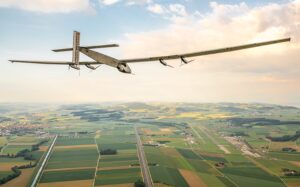 We are all used to alternative forms of energy these days. From electric cars to solar heating to wind energy, things have changed some. One thing I had never heard of before, however, is a solar-powered airplane. Of course, the plane was built to promote green energy, and I don’t personally think that green energy is a totally feasible option…sorry if anyone disagrees. Nevertheless, someone came up with the idea of using solar energy for an airplane. I have to admit that the idea of a plane operating totally on solar energy is something that would make me a little apprehensive, nevertheless, one was developed. And it was successful too. A solar-powered airplane completing the 10th leg of it’s journey by landing in Arizona after a 16-hour flight from California in 2015. Now, admittedly, a normal plane could have made the trip in a couple of hours, so in that way, it was rather anticlimactic.
We are all used to alternative forms of energy these days. From electric cars to solar heating to wind energy, things have changed some. One thing I had never heard of before, however, is a solar-powered airplane. Of course, the plane was built to promote green energy, and I don’t personally think that green energy is a totally feasible option…sorry if anyone disagrees. Nevertheless, someone came up with the idea of using solar energy for an airplane. I have to admit that the idea of a plane operating totally on solar energy is something that would make me a little apprehensive, nevertheless, one was developed. And it was successful too. A solar-powered airplane completing the 10th leg of it’s journey by landing in Arizona after a 16-hour flight from California in 2015. Now, admittedly, a normal plane could have made the trip in a couple of hours, so in that way, it was rather anticlimactic.
The plane was the brain-child of Bertrand Piccard, who dreamed of an airplane of perpetual endurance…able to fly day and night without fuel. With the construction of this plane, that dream had been realized, and with the flight of co-founder Andre Borschberg’s flight, history had been made. Still, who has 16 hours to make that flight, when you can drive it in 12 hours. The spindly, single-seat experimental aircraft, dubbed Solar Impulse 2, arrived in Phoenix shortly before 9pm, following a flight from San Francisco that took it over the Mojave  Desert. The solar plane’s pilots were required to take up meditation and hypnosis in training, so they could stay alert for long periods.
Desert. The solar plane’s pilots were required to take up meditation and hypnosis in training, so they could stay alert for long periods.
The plane’s capacity was one…just the pilot in the tiny cockpit. Andre Borschberg, who alternated with fellow pilot Bertrand Piccard at the controls for each segment of what they hope will be the first round-the-world solar-powered flight. “I made it to Phoenix, what an amazing flight over the Mojave desert,” Borschberg said in a Twitter post. Borschberg was the pilot for the Japan-to-Hawaii trip over the Pacific last July, staying airborne for nearly 118 hours…shattering the prior record of 76 hours for a non-stop, solo flight set back in 2006 by the late Steven Fossett in his Virgin Atlantic Global Flyer. Solar Impulse 2 set new duration and distance records for solar-powered flight too.
Not all was picture-perfect with the venture, however. The project was dealt a setback when the Solar Impulse suffered severe battery damage, requiring repairs and testing that grounded it in Hawaii for nine months. After repairs were made, Piccard completed the trans-Pacific crossing, reaching San Francisco after a flight of nearly three days, more than three times the 18 hours Amelia Earhart took to fly solo from Hawaii to California in the 1930s. In many ways, the project would seem to be a failure, but the one real success it had was that the 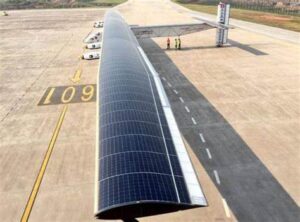 flights were made without fuel. Its four engines were powered solely by energy collected from more than 17,000 solar cells built into its wings. Surplus power is stored in four batteries during the day, to keep the plane aloft on extreme long-distance flights. The carbon-fiber plane, with a wingspan exceeding that of a Boeing 747 and the weight of a family car, is unlikely to set speed or altitude records. It can climb to 28,000 feet, and cruise at 34 to 62 miles per hour. It’s not something I think I would choose to fly in, but then it’s possible that down the road, when it isn’t an experimental plane, and it can carry more people, I might find myself traveling in just such a plane.
flights were made without fuel. Its four engines were powered solely by energy collected from more than 17,000 solar cells built into its wings. Surplus power is stored in four batteries during the day, to keep the plane aloft on extreme long-distance flights. The carbon-fiber plane, with a wingspan exceeding that of a Boeing 747 and the weight of a family car, is unlikely to set speed or altitude records. It can climb to 28,000 feet, and cruise at 34 to 62 miles per hour. It’s not something I think I would choose to fly in, but then it’s possible that down the road, when it isn’t an experimental plane, and it can carry more people, I might find myself traveling in just such a plane.
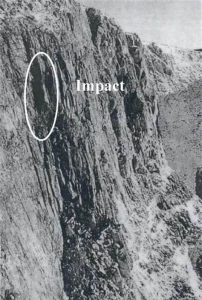
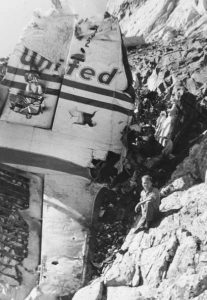 Wyoming doesn’t have as many plane crashes as other states…at least not to my knowledge. It’s probably because of the fact that with a smaller population, there are fewer flights in and out…at least in the past. That may have changed in more recent years. Nevertheless, on October 6, 1966, a DC-4…United Airlines Flight 409, with 66 people on board, flew into the side of a cliff on Medicine Bow Peak in the Snowy Mountain Range near Laramie, Wyoming. At that time, it was the worst air disaster in United States history.
Wyoming doesn’t have as many plane crashes as other states…at least not to my knowledge. It’s probably because of the fact that with a smaller population, there are fewer flights in and out…at least in the past. That may have changed in more recent years. Nevertheless, on October 6, 1966, a DC-4…United Airlines Flight 409, with 66 people on board, flew into the side of a cliff on Medicine Bow Peak in the Snowy Mountain Range near Laramie, Wyoming. At that time, it was the worst air disaster in United States history.
Lost in the disaster were three crew members, two infants, several military personnel, and five female members of the Mormon Tabernacle Choir. Their four-engine propeller plane took off from the now-closed Stapleton International Airport in Denver that morning. Its destination was Salt Lake City, Utah. Jet airliners didn’t exist then, and propeller-driven airplanes necessarily flew at much lower altitudes. Things like not being able to pressurize the cabin, necessitated a lower flight level. Unfortunately, it also made air travel quite a bit more hazardous. Things like terrain collisions and weather issues were more common. Weather forecasts weren’t as sophisticated and the widely dispersed technology we have today was still a dream in some scientists mind.
The normal flight path of the Denver to Salt Lake route in those days, was north of Laramie around the high points of the Snowy Mountain Range. It seems to be a long way around to us these days, but it was necessary back then. Still, pilots would occasionally fly over the range to save time. In retrospect, I’m sure many would regret that practice after hearing about United Airlines Flight 409, and the horrible outcome of that shortcut.
The night of October 5th brought high winds and snow…both normal for Wyoming this time of year. The conditions over the mountains were most likely less than ideal as UA409 crossed the range the next morning. At 7:26am on October 6th, the plane flew into the side of the mountain…at full speed. There were no “black boxes” at that, so the only way to determine the time was that the onboard clocks that were recovered after the crash were frozen at the moment of impact. According to the investigation report, the plane exploded on impact, littering the mountain with debris over a mile-long path. Two huge black marks marred the mountain, as oil from the engines splattered across the surrounding terrain. The impact site was just 25 feet below the crest of the mountain, at 12,000 feet…25 feet from clearing the top. That is so shocking…that I find it difficult to wrap my mind around that fact. If they could have made it just a little over 25 feet higher, they just might have made it.
After the impact, the tail section separated from the rest of the aircraft, fell down the cliff, and rested on a ledge halfway down. A search for the plane ensued, and an F-80 fighter jet based out of Cheyenne spotted the wreck a little more than four hours after the crash. The pilots of the jet told of bad weather in the area. With the location, rescuers headed to the area, but with the windy weather caused, it took several attempts to locate the wreckage. It took them until Thursday afternoon to actually reach the crash site. Then began the gruesome task of recovering the dead. Bodies were lowered by rope and pully down the cliff. Some bags were marked “spare parts.” All the dead were identified, and their remains carried out on horseback.
To this day, the cause of the crash is uncertain. The pilot was very skilled, and the shortcut over the mountain would not have saved a lot of time. It is unknown why he took the shortcut, or why he flew at such a low 
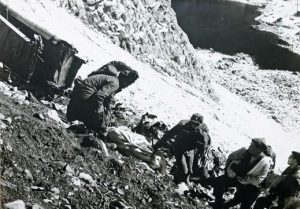 altitude. The wreckage remains at the site to this day, as often happened back then. A hiker made a YouTube video of his trip there, where he found pieces of scrap metal, wires, and rusted engine parts from the plane. He also found a shoe that appears to be from that era. I imagine the finds left the hiker with a feeling of being in an almost hallowed ground…almost like a grave site.
altitude. The wreckage remains at the site to this day, as often happened back then. A hiker made a YouTube video of his trip there, where he found pieces of scrap metal, wires, and rusted engine parts from the plane. He also found a shoe that appears to be from that era. I imagine the finds left the hiker with a feeling of being in an almost hallowed ground…almost like a grave site.
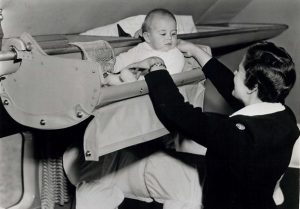 Air travel has changed a lot over the years, especially where babies are concerned. These days babies are placed in car seats just like they are when traveling in cars, but in years past, that was not the case. Of course, the invention of the car seat has saved countless lives in car and air travel. Nevertheless, years ago people didn’t have car seats. In those days babies were often held on their parents laps, but even that wasn’t as odd as the way babies traveled in the mid-1950s.
Air travel has changed a lot over the years, especially where babies are concerned. These days babies are placed in car seats just like they are when traveling in cars, but in years past, that was not the case. Of course, the invention of the car seat has saved countless lives in car and air travel. Nevertheless, years ago people didn’t have car seats. In those days babies were often held on their parents laps, but even that wasn’t as odd as the way babies traveled in the mid-1950s.
It was thought that babies needed to be able to sleep on the trip, and so the 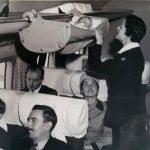 planes had a “cradle” that attached to the baggage area, and the bed folded down. Called skycots, the beds allowed the baby to lay down and maybe sleep through the flight. If you have ever traveled with a baby, you know that if they get fussy because of things like ear pressure from being so high, it is going to be miserable for everyone. Air stewards were actually tasked with attending to the children during the flight. The babies were pretty much in the skycot for the duration of the trip. It was almost like putting your baby in the luggage bin…not something most of us would even consider these days. Parents were required to hold their baby during take-off and landing, of course,
planes had a “cradle” that attached to the baggage area, and the bed folded down. Called skycots, the beds allowed the baby to lay down and maybe sleep through the flight. If you have ever traveled with a baby, you know that if they get fussy because of things like ear pressure from being so high, it is going to be miserable for everyone. Air stewards were actually tasked with attending to the children during the flight. The babies were pretty much in the skycot for the duration of the trip. It was almost like putting your baby in the luggage bin…not something most of us would even consider these days. Parents were required to hold their baby during take-off and landing, of course, 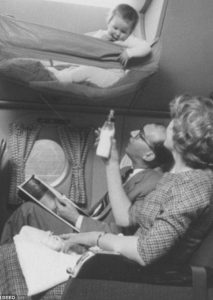 because the babies were not buckled into the skycots. I don’t suppose they would have liked it if they were, but there really wasn’t a way to do that anyway, so they were just placed in the sky cot like a cradle or crib. To me it also seems an odd way to do things, because what of the baby who could sit up or climb over the side? The whole thing would make the average parent worry, but in those days it was just the way it was…just like having your kids in the car unbuckled…which was completely normal when I was a kid.
because the babies were not buckled into the skycots. I don’t suppose they would have liked it if they were, but there really wasn’t a way to do that anyway, so they were just placed in the sky cot like a cradle or crib. To me it also seems an odd way to do things, because what of the baby who could sit up or climb over the side? The whole thing would make the average parent worry, but in those days it was just the way it was…just like having your kids in the car unbuckled…which was completely normal when I was a kid.
While pictures seemed to show the happy babies relaxing in their sky cot, the reality is that planes in the 50s were noisy, and turbulent. My guess is that the pictures taken before takeoff, were not exactly how the flights went. In addition, many babies are not too keen on the idea of some stranger taking care of them on the plane, especially since they can’t always see their parents. Parents gave their babies a bottle of milk in an effort to appease them and lull them to sleep. I wonder just how well that worked.
 Most airplane malfunctions leave the captain and flight crew able to at least attempt a somewhat controlled crash landing, but that was not the case with USAir Flight 427. One minute, everything was going perfectly, and the next, the plane had flipped over and was plummeting toward the ground, nose first. The pilot, Captain Peter Germano had been sipping a cranberry-orange juice and Diet Sprite drink 10 minutes before the crash, and then gave the cabin a standard weather report for Pittsburgh less than three minutes before the plane went down. It was a smooth flight all the way, and there were no anticipated problems.
Most airplane malfunctions leave the captain and flight crew able to at least attempt a somewhat controlled crash landing, but that was not the case with USAir Flight 427. One minute, everything was going perfectly, and the next, the plane had flipped over and was plummeting toward the ground, nose first. The pilot, Captain Peter Germano had been sipping a cranberry-orange juice and Diet Sprite drink 10 minutes before the crash, and then gave the cabin a standard weather report for Pittsburgh less than three minutes before the plane went down. It was a smooth flight all the way, and there were no anticipated problems.
The pilots had no warning. Just 28 seconds before the crash, the pilots’ desperate exclamations are heard as the wings begin to shake and cockpit alarms sound. Germano says, “Sheez,” on the heels of three electrical clicks just before 7:03pm The Boeing 737-300 rolled to the left and dives. Germano breathes heavily and says, “Whoa,” as a thump and some clicking is heard. Another click is heard and Germano says, “Hang on.” The captain screamed and the co-pilot said, “God . . . no!” as a USAir jet spun out of control and dove about a mile nose first to the ground, killing all 132 people aboard. The flight had been completely normal until the last 28 seconds. There was no time to fix anything, and they didn’t know what to fix anyway.
“There is no indication that there was a criminal act involved in the crash,” one of the investigators said. There  was no explosion. They began to look at things like turbulence on the Boeing 737-300…to whether the pilots had been properly trained to recover from trouble in the air. Among the areas of the plane to be examined was the possibility of a rudder malfunction. USAir has warned pilots of its Boeing 737s to watch out for spontaneous rudder movements during flights. The rudder is a large vertical tail slab that moves a plane left or right.
was no explosion. They began to look at things like turbulence on the Boeing 737-300…to whether the pilots had been properly trained to recover from trouble in the air. Among the areas of the plane to be examined was the possibility of a rudder malfunction. USAir has warned pilots of its Boeing 737s to watch out for spontaneous rudder movements during flights. The rudder is a large vertical tail slab that moves a plane left or right.
After USAir Flight 427, a Boeing 737-300, crashed outside Pittsburgh on September 8, 1994, Boeing claimed the crash, which killed all 132 people on board, was caused by pilot error. The pilots’ union claimed the Boeing 737 was defective. A series of clues unearthed through meticulous detective work pointed to a problem in that prior Flight 427’s power control unit, which is a hydraulic device that controls the movement of the rudder. Investigators zeroed in on a suspicious servo valve in the power control unit. One of the manufacturers recalled a failed test, in which, for a second or two the valve stuck. The test was called thermal shock, and involved injecting hot hydraulic fluid into a valve that had been frozen to -40° to simulate the temperature in flight to the worst case scenario. At one point, the test failed, and then after the valve was adjusted, it passed. With the valve-in-a-valve system in the 737, it was expected that if the outer vale failed, the inner valve would compensate for the failure by injecting more fluid to bring the rudder back to the neutral position.
But as an analyst named Kitka studied the squiggly lines for the return flow now, he saw dips that were not 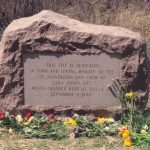 supposed to be there. When he matched them to another graph showing the force on the levers inside the PCU, he made an alarming discovery. When the outer valve had jammed, the inner valve had moved too far to compensate. That meant the rudder would not have returned to neutral, the way it was supposed to. The rudder would have reversed. That could be catastrophic, and in fact, it was. A pilot would push on the left pedal, expecting the rudder to go left, but it would go right, causing the plane to flip over and nosedive into the ground in a matter of seconds, with no possible fix on the part of the pilot and crew. There simply wasn’t enough time to fix the problem, and no way to do so anyway. Of course, the planes were grounded until they were fixed, but for the passengers and crew of USAir Flight 427, it was too late.
supposed to be there. When he matched them to another graph showing the force on the levers inside the PCU, he made an alarming discovery. When the outer valve had jammed, the inner valve had moved too far to compensate. That meant the rudder would not have returned to neutral, the way it was supposed to. The rudder would have reversed. That could be catastrophic, and in fact, it was. A pilot would push on the left pedal, expecting the rudder to go left, but it would go right, causing the plane to flip over and nosedive into the ground in a matter of seconds, with no possible fix on the part of the pilot and crew. There simply wasn’t enough time to fix the problem, and no way to do so anyway. Of course, the planes were grounded until they were fixed, but for the passengers and crew of USAir Flight 427, it was too late.
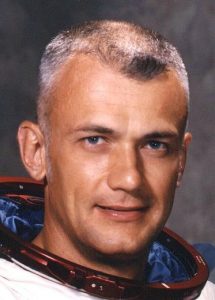 These days, lots of people have used hang-gliders, or squirrel suits, or parachutes to be able to “fly” without the use of an airplane, and lots of people absolutely love the rush they get from it. I suppose it would be very cool, but the clear fact is that, in reality, you are performing a fall of sorts, with a landing definitely in the future. There is no ability to go back up with the equipment you have.
These days, lots of people have used hang-gliders, or squirrel suits, or parachutes to be able to “fly” without the use of an airplane, and lots of people absolutely love the rush they get from it. I suppose it would be very cool, but the clear fact is that, in reality, you are performing a fall of sorts, with a landing definitely in the future. There is no ability to go back up with the equipment you have.
I guess that makes the flight that Captain Bruce McCandless II took on February 7, 1984 very unique. McCandless was a NASA astronaut aboard the space shuttle Challenger, as a mission specialist on STS-41B (February 3-11, 1984), when he became the first human to fly in space…untethered. This is not a falling situation. In fact, had he not initiated the jet packs power to maneuver his way back to the shuttle, he could have floated around in space forever. Of course, he did not choose to do that, and so after 5 hours and 55 minutes, McCandless maneuvered the bulky white rocket pack, of his own design, back to the space shuttle. I think that deep down inside him, he must have thought, “No!!! I don’t want it to be over yet!!” The feeling of exhilaration over what he had accomplished, must have give him the ultimate adrenalin rush!! A rush like no one else had ever felt before. McCandless orbited the Earth in tangent with the shuttle at speeds greater than 17,500 miles per hour and flew up to 320 feet away from the Challenger. Then, after an hour and a half testing and flying the jet-powered backpack and admiring Earth, McCandless safely reentered the shuttle.
Later that day, Army Lieutenant Colonel Robert Stewart tried out the rocket pack, which was a device regarded as an important step toward future operations to repair and service orbiting satellites and to assemble and 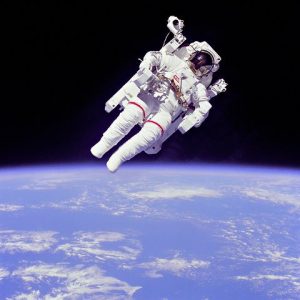 maintain large space stations. It was the fourth orbital mission of the space shuttle Challenger. His untethered space walk lasted 6 hours and 17 minutes. The rocket pack worked beautifully. It was a great advancement, but my mind goes back to the man. How did he feel when he took that first step out into space, knowing that if this didn’t go as planned, he could be lost in space forever? Then, he took a leap of faith, and stepped out. It must have been exhilarating and terrifying at the same time. Then when he realized that he could make the rocket pack do what he wanted it to, he must have been elated. What a rush that must have been, and for just a little while, he was alone…not only in space, but in that fact that he was the only one who had been there without being tied to a shuttle for safety. How amazing that must have been.
maintain large space stations. It was the fourth orbital mission of the space shuttle Challenger. His untethered space walk lasted 6 hours and 17 minutes. The rocket pack worked beautifully. It was a great advancement, but my mind goes back to the man. How did he feel when he took that first step out into space, knowing that if this didn’t go as planned, he could be lost in space forever? Then, he took a leap of faith, and stepped out. It must have been exhilarating and terrifying at the same time. Then when he realized that he could make the rocket pack do what he wanted it to, he must have been elated. What a rush that must have been, and for just a little while, he was alone…not only in space, but in that fact that he was the only one who had been there without being tied to a shuttle for safety. How amazing that must have been.
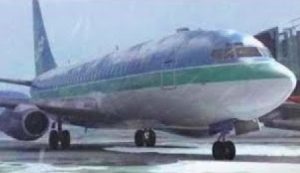 January 13, 1982 found Washington DC in the middle of a severe snowstorm. The Washington National Airport was closed due to heavy snowfall…in excess of 6.5 inches. The airport reopened at noon under barely marginal conditions, but decreasing snow. The planes that had been waiting, began the de-icing process, including an Air Florida Boeing 727. The plane had flown into Washington from Miami in the early afternoon and was supposed to return to Fort Lauderdale, Florida, after a short stop. The short layover turned into a much longer one when the airport closed. When it reopened, the plane was de-iced with chemical anti-freeze, but the planes still had difficulty moving away from the gate due to the ice, so when it eventually made it to the airport’s only usable runway, it was forced to wait 45 minutes more for clearance to take off.
January 13, 1982 found Washington DC in the middle of a severe snowstorm. The Washington National Airport was closed due to heavy snowfall…in excess of 6.5 inches. The airport reopened at noon under barely marginal conditions, but decreasing snow. The planes that had been waiting, began the de-icing process, including an Air Florida Boeing 727. The plane had flown into Washington from Miami in the early afternoon and was supposed to return to Fort Lauderdale, Florida, after a short stop. The short layover turned into a much longer one when the airport closed. When it reopened, the plane was de-iced with chemical anti-freeze, but the planes still had difficulty moving away from the gate due to the ice, so when it eventually made it to the airport’s only usable runway, it was forced to wait 45 minutes more for clearance to take off.
Not wanting to further delay the flight, the pilot, Larry Wheaton, did not return to the terminal for more de-icing, and worse, failed to turn on the plane’s own de-icing system. In fact, the pilot and co-pilot actually discussed the situation, and the co-pilot said “It’s a losing battle trying to de-ice these things. It gives you a false sense of security, that’s all it does.” During the delay, however, ice was accumulating on the wings, and 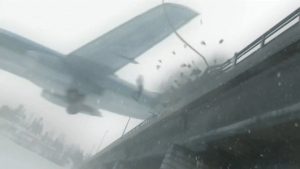 by the time the plane reached the end of the runway, it was able to achieve only a few hundred feet of altitude.
by the time the plane reached the end of the runway, it was able to achieve only a few hundred feet of altitude.
The Air Florida flight took off from Washington National Airport in Arlington, Virginia, with 74 passengers and 5 crew members on board. Thirty seconds later, the plane crashed into the 14th Street Bridge over the Potomac River, less than a mile away from the runway. Seven vehicles traveling on the bridge were struck by the 727 and the plane fell into the freezing water. It was later determined that 73 of the people on board the plane died from the impact, leaving only six survivors in the river. In addition, four motorists, who had been on the bridge, died in the crash. Terrible traffic in Washington that day made it almost impossible for rescue workers to reach the scene. Witnesses didn’t know what to do to assist the survivors who were stuck in the freezing river. Finally, a police helicopter arrived and began assisting the survivors in a very risky operation.
Two people in particular emerged as heroes during the rescue…Arland Williams and Lenny Skutnik. Known as 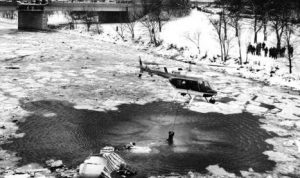 the “sixth passenger,” Williams survived the crash, and passed lifelines on to others rather than take one for himself. He ended up being the only plane passenger to die from drowning. When one of the survivors to whom Williams had passed a lifeline was unable to hold on to it, Skutnik, who was watching the unfolding tragedy, jumped into the water and swam to rescue her. Both Skutnik and Williams, along with bystander Roger Olian, received the Coast Guard Gold Lifesaving Medal. The bridge was later renamed the Arland D. Williams Jr. Memorial Bridge. It was a completely preventable tragedy, and all because they got in a hurry.
the “sixth passenger,” Williams survived the crash, and passed lifelines on to others rather than take one for himself. He ended up being the only plane passenger to die from drowning. When one of the survivors to whom Williams had passed a lifeline was unable to hold on to it, Skutnik, who was watching the unfolding tragedy, jumped into the water and swam to rescue her. Both Skutnik and Williams, along with bystander Roger Olian, received the Coast Guard Gold Lifesaving Medal. The bridge was later renamed the Arland D. Williams Jr. Memorial Bridge. It was a completely preventable tragedy, and all because they got in a hurry.
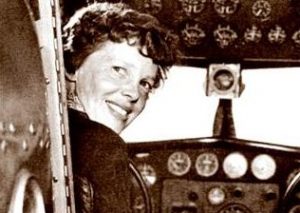 Recently, I discovered that Amelia Earhart is my 8th cousin once removed on my dad, Allen Spencer’s side of my family. Prior to this time, I knew of Amelia and her accomplishments, as well as her disappearance, but other than the fact that the whole thing was sad, it really didn’t affect me very much. Maybe it’s the fact that I now know that she is a relative, or maybe it’s the fact that the whole plot of the mystery seems to have thickened with some new information. Either way, I find myself intrigued by this new information.
Recently, I discovered that Amelia Earhart is my 8th cousin once removed on my dad, Allen Spencer’s side of my family. Prior to this time, I knew of Amelia and her accomplishments, as well as her disappearance, but other than the fact that the whole thing was sad, it really didn’t affect me very much. Maybe it’s the fact that I now know that she is a relative, or maybe it’s the fact that the whole plot of the mystery seems to have thickened with some new information. Either way, I find myself intrigued by this new information.
Amelia Earhart vanished eighty years ago. She was last heard from on July 2, 1937. It was assumed that her plane had crashed during an attempt to become the first woman to circumnavigate the globe, and since she was never heard from again, most people, myself included, were sure that she had crashed. For eighty years, it was pretty much settled…until someone looked at a photograph in a long forgotten file, that suggests that she may not have crashed, but rather crash landed in the Marshall Islands, and was possibly taken prisoner, along with her navigator. The photo, found in a long-forgotten file in the National Archives, shows a woman who resembles Earhart and a man who appears to be her navigator, Fred Noonan, on a dock. The discovery is featured in a new History channel special, “Amelia Earhart: The Lost Evidence.”
The photograph suggests that Amelia Earhart, survived a crash landing in the Marshall Islands. I’m sure there are many people who doubt the authenticity of the photograph, but independent analysts told the History Channel that the photo appears legitimate and undoctored. Shawn Henry, former executive assistant director for the FBI and an NBC News analyst, has studied the photo and feels confident it shows the famed pilot and her navigator. Henry told NBC news, “When you pull out, and when you see the analysis that’s been done, I think it leaves no doubt to the viewers that that’s Amelia Earhart and Fred Noonan.”
These days, with so much fake news, and so much speculation about things, it’s hard to believe things sometimes. Still, so much of this evidence seems to point to facts very different from the theories we have 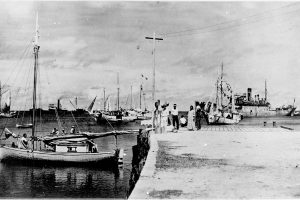 believed to be truth for so long. We know that Earhart was last heard from on July 2, 1937, as she made her quest to become the first woman pilot to circumnavigate the globe. She was declared dead two years later after the United States concluded she had crashed somewhere in the Pacific Ocean, but her remains were never found. Now, these investigators believe they have found evidence that Earhart and Noonan were blown off course, but survived the ordeal. The investigative team behind the History channel special believes the photo may have been taken by some secret spy for the United States on Japanese military activity in the Pacific. It is not clear how Earhart and Noonan could have flown so far off course.
believed to be truth for so long. We know that Earhart was last heard from on July 2, 1937, as she made her quest to become the first woman pilot to circumnavigate the globe. She was declared dead two years later after the United States concluded she had crashed somewhere in the Pacific Ocean, but her remains were never found. Now, these investigators believe they have found evidence that Earhart and Noonan were blown off course, but survived the ordeal. The investigative team behind the History channel special believes the photo may have been taken by some secret spy for the United States on Japanese military activity in the Pacific. It is not clear how Earhart and Noonan could have flown so far off course.
Les Kinney, a retired government investigator has spent 15 years looking for Earhart clues, about what really happened to her. He said the photo “clearly indicates that Earhart was captured by the Japanese.” Japanese authorities told NBC News they have no record of Earhart being in their custody, but then it is doubtful that they would have been honest with us if they had her. The photo, marked “Jaluit Atoll” and believed to have been taken in 1937, shows a short-haired woman, believed to be Earhart, sitting on a dock with her back to the camera. Like Earhart, the woman was wearing pants, something for which Earhart was known, even though it was odd in those days. Near her is a standing man who looks like Noonan, so much so that when a transparent photo of him fits it perfectly…down to the hairline. “The hairline is the most distinctive characteristic,” said Ken Gibson, a facial recognition expert who studied the image. “It’s a very sharp receding hairline. The nose is very prominent.” Gibson added, “It’s my feeling that this is very convincing evidence that this is probably Noonan.” The photo also shows a Japanese ship, Koshu, towing a barge with something that appears to be 38 feet long airplane…the same length as Earhart’s plane. The locals have continued to claim that they saw Earhart’s plane crash before she and Noonan were taken away. Native school kids insisted they saw Earhart in captivity. The story was even documented in postage stamps issued in the 1980s. “We believe that the Koshu took her to Saipan, in the [Mariana Islands], and that she died there under the custody of the 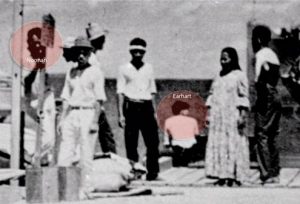 Japanese,” said Gary Tarpinian, the executive producer of the History special. “We don’t know how she died,” Tarpinian said. “We don’t know when.” Josephine Blanco Akiyama, who lived on Saipan as a child, has long claimed she saw Earhart in Japanese custody. “I didn’t even know it was a woman, I thought it was a man,” said Akiyama. “Everybody was talking about her — they were talking about in Japanese. That’s why I know that she’s a woman. They were talking about a woman flyer.” It is not clear if the United States government knew who was in the photo, or if it was taken by a spy, the United States may not have wanted to compromise that person by revealing the image. If that were the case, sadly two lives were sacrificed for one.
Japanese,” said Gary Tarpinian, the executive producer of the History special. “We don’t know how she died,” Tarpinian said. “We don’t know when.” Josephine Blanco Akiyama, who lived on Saipan as a child, has long claimed she saw Earhart in Japanese custody. “I didn’t even know it was a woman, I thought it was a man,” said Akiyama. “Everybody was talking about her — they were talking about in Japanese. That’s why I know that she’s a woman. They were talking about a woman flyer.” It is not clear if the United States government knew who was in the photo, or if it was taken by a spy, the United States may not have wanted to compromise that person by revealing the image. If that were the case, sadly two lives were sacrificed for one.
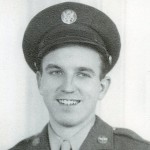 As a young man of just under 20 years, my dad made his first trip overseas. It was the height of World War II, and Dad was the Top Turret Gunner and Flight Engineer on a B-17G Bomber in the 8th Air Force 385th Bomber Group. His bomber group had flown to Great Ashfield, Suffolk, England early that April. While they were at war, and that was a scary thing for any sane person, there was also a part on my almost 20 year old future dad that felt a bit of excitement. He was in a new country…an old country by the world’s standards, with things and places we just didn’t have in the relatively young United States. There were castles and old churches to see. In the United State, we had churches built of logs and wood, and modest homes often built the same way, but in England, there were buildings that had an artistic side to them. There were so many sights that he would not be able to see at home, and might never see again. No wonder her was excited.
As a young man of just under 20 years, my dad made his first trip overseas. It was the height of World War II, and Dad was the Top Turret Gunner and Flight Engineer on a B-17G Bomber in the 8th Air Force 385th Bomber Group. His bomber group had flown to Great Ashfield, Suffolk, England early that April. While they were at war, and that was a scary thing for any sane person, there was also a part on my almost 20 year old future dad that felt a bit of excitement. He was in a new country…an old country by the world’s standards, with things and places we just didn’t have in the relatively young United States. There were castles and old churches to see. In the United State, we had churches built of logs and wood, and modest homes often built the same way, but in England, there were buildings that had an artistic side to them. There were so many sights that he would not be able to see at home, and might never see again. No wonder her was excited.
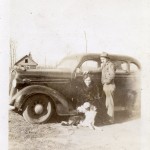 Dad knew of the dangers he and his fellow crewmen were facing in England and over Europe, but the excitement of being in a completely different country, so far away from home was something that was hard not to like. He found the people interesting, the structures elegant and beautiful, and the climate different from what he was used to. Of course, he missed his family, and wanted to make sure his mother didn’t worry too much, so that might have also been the reason that he always tried keep his letters light. For me, having the advantage of knowing that he made it through the war and came home safely, it is easy to look beyond my dad’s careful words, to the excitement that lies behind them. Dad always loved to travel, and while this was clearly different, it was still travel, and by airplane, no less. What young man of 19 years wouldn’t be excited about all the new things he was able to do and see.
Dad knew of the dangers he and his fellow crewmen were facing in England and over Europe, but the excitement of being in a completely different country, so far away from home was something that was hard not to like. He found the people interesting, the structures elegant and beautiful, and the climate different from what he was used to. Of course, he missed his family, and wanted to make sure his mother didn’t worry too much, so that might have also been the reason that he always tried keep his letters light. For me, having the advantage of knowing that he made it through the war and came home safely, it is easy to look beyond my dad’s careful words, to the excitement that lies behind them. Dad always loved to travel, and while this was clearly different, it was still travel, and by airplane, no less. What young man of 19 years wouldn’t be excited about all the new things he was able to do and see.
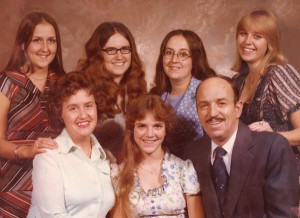 My dad has been in Heaven for almost ten years now, and I miss him terribly. His kindhearted ways endeared him to everyone from family to friends. Dad was always the thoughtful one…always a gentle man…and a gentleman. He wasn’t harsh, and he was always a gentleman when it came to treating women in the way they should be treated. Dad was quite possibly the last of the Southern Gentlemen…even if he wasn’t from the South. Looking back now on the ten years that he has been gone, I know that I miss him just as much today, as the day he left us…and I always will. Happy birthday in Heaven Dad. I know you and Mom are having a fine time. Just know that you are always in our thoughts. We love and miss you so much.
My dad has been in Heaven for almost ten years now, and I miss him terribly. His kindhearted ways endeared him to everyone from family to friends. Dad was always the thoughtful one…always a gentle man…and a gentleman. He wasn’t harsh, and he was always a gentleman when it came to treating women in the way they should be treated. Dad was quite possibly the last of the Southern Gentlemen…even if he wasn’t from the South. Looking back now on the ten years that he has been gone, I know that I miss him just as much today, as the day he left us…and I always will. Happy birthday in Heaven Dad. I know you and Mom are having a fine time. Just know that you are always in our thoughts. We love and miss you so much.
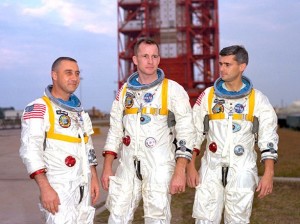
 The NASA Space Program had suffered relatively few losses during it’s many years of existence, but when something happens, it is felt around the world. Like a plane crash, it hits everyone very hard. What I find very strange is the fact that NASA’s three tragedies that brought about loss of life, while years apart, all took place within a week’s time of each other. All three of these losses were very different in how they happened. The January 27, 1967 fire on the launch pad that took the lives of Virgil “Gus” Grissom, Edward White II, Roger Chaffee in a routine ground test of the capsule that would later become Apollo 1 was a fire started by an electrical spark. The fire engulfed their high-pressurized, pure-oxygen cabin, and the astronauts suffocated. There was no emergency release on the door. They couldn’t get out. The Challenger, was lost on the 28th of January, 1986. It blew up during launch because an O-ring failed when the fuel tanks were stirred, killing all seven of the astronauts, and leaving the nation in mourning at the loss of Francis “Dick” Scobee, Ron McNair, Mike Smith, Ellison Onizuka, Judy Resnik, Greg Jarvis, and Christa McAuliffe.
The NASA Space Program had suffered relatively few losses during it’s many years of existence, but when something happens, it is felt around the world. Like a plane crash, it hits everyone very hard. What I find very strange is the fact that NASA’s three tragedies that brought about loss of life, while years apart, all took place within a week’s time of each other. All three of these losses were very different in how they happened. The January 27, 1967 fire on the launch pad that took the lives of Virgil “Gus” Grissom, Edward White II, Roger Chaffee in a routine ground test of the capsule that would later become Apollo 1 was a fire started by an electrical spark. The fire engulfed their high-pressurized, pure-oxygen cabin, and the astronauts suffocated. There was no emergency release on the door. They couldn’t get out. The Challenger, was lost on the 28th of January, 1986. It blew up during launch because an O-ring failed when the fuel tanks were stirred, killing all seven of the astronauts, and leaving the nation in mourning at the loss of Francis “Dick” Scobee, Ron McNair, Mike Smith, Ellison Onizuka, Judy Resnik, Greg Jarvis, and Christa McAuliffe.
The third NASA loss took place on February 1, 2003, and this one happened on re-entry into our atmosphere. The damage that caused the demise of the Space Shuttle Columbia happened during the launch, when a piece of foam insulation broke off and damaged the leading edge of the wing. When the shuttle re-entered the Earth’s atmosphere, the wind and heat entered the wing and blew it apart, because the heat-resistant tiles covering the left wing’s leading edge had been damaged or were missing. Pieces of the shuttle began raining down across Texas, as well as the bodies of the astronauts. This loss was very different than the others, in that is was a much less controlled situation. The prior losses could be cordoned off and kept out of the public view, but the way that Columbia was damaged, far above the Earth, causing it to rain down over such a large area, made it impossible to control, and consequently, people were coming across bodies and debris. I can’t imagine anything worse, because these were our beloved astronauts, and this was such an undignified end. It was heart wrenching for everyone in this nation. We will always remember Rick Husband, Willie McCool, Michael Anderson, Kalpana Chawla, David Brown, Laurel Clark and Israeli astronaut Ilan Ramon.
With the end of the space shuttle portion of the NASA program, the future of our nation’s work in space seems to be in question. It is hard for me to imagine going from the Space Shuttle, with the amazing ability to land like an airplane, back to a rocket. The new Orion rocket is designed to go further that any other spacecraft, and 
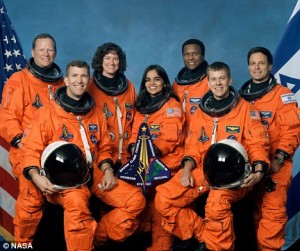 the astronauts are used to living in space for six months at a time, so the possibilities are endless, and only time will tell. With each loss come a new wisdom and increased knowledge about the things that make our astronauts unsafe, and what things can keep them safe on their journeys into the unknown. Today, however, is a day to remember NASA’s lost ones on the twelfth anniversary of the loss of the Space Shuttle Columbia.
the astronauts are used to living in space for six months at a time, so the possibilities are endless, and only time will tell. With each loss come a new wisdom and increased knowledge about the things that make our astronauts unsafe, and what things can keep them safe on their journeys into the unknown. Today, however, is a day to remember NASA’s lost ones on the twelfth anniversary of the loss of the Space Shuttle Columbia.

 When it comes to teaching babies how to do things, it seems like we all want a part in it. We may not even realize that we do, but we do. As mothers, we try many things to get our babies to eat solid foods…especially those dreaded vegetables. You might see a mother pretending that the spoon is an airplane or a train, hoping that her child will decide that food on a train or plane tastes better, or won’t notice that the dreaded vegetable has been eaten. Maybe those things work and maybe they don’t but either way, they can look very funny, and to think that as teenagers we were always thought of as pretty cool…so what happened? The thing I find really funny is that the mother always opens her mouth to apparently show the child what he needs to do. Like a kid who hates his vegetables is going to open his mouth just because his mommy did, right. I think not. Of course the funniest face in the food game is that of a child who absolutely hates the food he is getting. They look like you have just given them poison and…seriously, how could you be such a bad parent, but have you ever noticed that even a baby who hates food, happens to find her toes, she has no problem putting those in her mouth.
When it comes to teaching babies how to do things, it seems like we all want a part in it. We may not even realize that we do, but we do. As mothers, we try many things to get our babies to eat solid foods…especially those dreaded vegetables. You might see a mother pretending that the spoon is an airplane or a train, hoping that her child will decide that food on a train or plane tastes better, or won’t notice that the dreaded vegetable has been eaten. Maybe those things work and maybe they don’t but either way, they can look very funny, and to think that as teenagers we were always thought of as pretty cool…so what happened? The thing I find really funny is that the mother always opens her mouth to apparently show the child what he needs to do. Like a kid who hates his vegetables is going to open his mouth just because his mommy did, right. I think not. Of course the funniest face in the food game is that of a child who absolutely hates the food he is getting. They look like you have just given them poison and…seriously, how could you be such a bad parent, but have you ever noticed that even a baby who hates food, happens to find her toes, she has no problem putting those in her mouth.
Something women tend to do for no real reason is the open mouth to put on mascara maneuver. I really don’t know what purpose this serves, but yes, I do it too. And, I don’t know of a single woman who wears mascara that doesn’t do that. Maybe it’s an instinct, but I simply can’t understand why. It’s rarely something I think of when I am putting on my mascara, but when it is mentioned…usually by a man…I have to wonder why I do it. They say that it doesn’t make it easier to get your mascara on, but they can’t convince my mouth of that fact. It just instinctively wants to help, just like the mom who opens her mouth to get baby to eat. I don’t know, maybe there really is an eye mouth connection.
Then, of course, there is the child having his first birthday. It’s only one candle, but for some reason, not even the baby’s breath can manage to blow it out. If you want those candles to stay lit, they simply won’t, but if baby is trying to blow them out, they are like a never ending flame. Have you ever looked around at the other 
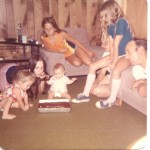 people who are watching? I’ll bet that about half of them have their mouth puckered up trying to help the baby blow out the candles. They aren’t blowing out any air, they are just puckered up…almost like they are throwing a kiss, and the baby just sits there looking at the pretty candle. I’m not even sure they really want to blow it out. Whatever the reason, you will find no such difficulty when told to eat that cake. That kid…even the one who hates everything, will dive right in, and have a totally different look on their face. But then, the look on your face might be different if you were eating cake too.
people who are watching? I’ll bet that about half of them have their mouth puckered up trying to help the baby blow out the candles. They aren’t blowing out any air, they are just puckered up…almost like they are throwing a kiss, and the baby just sits there looking at the pretty candle. I’m not even sure they really want to blow it out. Whatever the reason, you will find no such difficulty when told to eat that cake. That kid…even the one who hates everything, will dive right in, and have a totally different look on their face. But then, the look on your face might be different if you were eating cake too.

